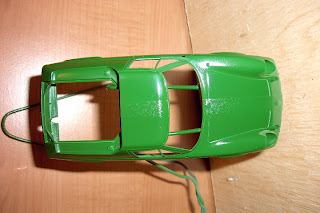 Both sides are neat and clean so I wanted to see the effect of water sanding before polishing. In this picture, the rear portion of the door is sanded with a grade 2000 paper. As fine as it seems to the touch, it is quite enough to scrape the surface and make it lose whatever shine it had. The side has then been rubbed with a 3M Grinding Compound. This cream is supposed to make any sanding with grade 1500 and above disappear. Truly enough, the shine comes back and it looks as new. I rubbed the model with a microfiber cloth so as not to damage the paint. I use such clothes on my real car, which is very dear to me, so they cannot hurt a model. Abrasiveness is very fine but effective as the cloth shows green paint onto it. The final step was a coat of wax, using an Armor All standard wax.
Both sides are neat and clean so I wanted to see the effect of water sanding before polishing. In this picture, the rear portion of the door is sanded with a grade 2000 paper. As fine as it seems to the touch, it is quite enough to scrape the surface and make it lose whatever shine it had. The side has then been rubbed with a 3M Grinding Compound. This cream is supposed to make any sanding with grade 1500 and above disappear. Truly enough, the shine comes back and it looks as new. I rubbed the model with a microfiber cloth so as not to damage the paint. I use such clothes on my real car, which is very dear to me, so they cannot hurt a model. Abrasiveness is very fine but effective as the cloth shows green paint onto it. The final step was a coat of wax, using an Armor All standard wax.  The initial surface was not half bad, so the effect is not particularly obvious. The picture tries to point out differences in light reflection. The border of the reflection looks finer where the paint was sanded. When the reflection spreads on both areas, the difference seems a bit more understandable. I would be very curious to see what the reflection would be if I had sanded with a grade 200 first and then with a finer grade paper. The aim is to have a totally sharp border on the reflection.
The initial surface was not half bad, so the effect is not particularly obvious. The picture tries to point out differences in light reflection. The border of the reflection looks finer where the paint was sanded. When the reflection spreads on both areas, the difference seems a bit more understandable. I would be very curious to see what the reflection would be if I had sanded with a grade 200 first and then with a finer grade paper. The aim is to have a totally sharp border on the reflection.However, unless I can one day make a really shiny body, I think I could live with that kind of finish. It looks quite on par with what toy makers provide on toy cars. I can see my own reflection on the finished sections of the model.
 I also tried a less-than-perfect section: the front left wing, which had a mate finish after the second wet coat of paint. The half-wing close to the headlight has been sanded but not the rest. The sanding could definitely be better, maybe if started with a grosser grade, because it cannot cover all the orange peel effect. Like I did for the side of the body, the Grinding Compound was thoroughly used on the whole wing, then wax was applied.
I also tried a less-than-perfect section: the front left wing, which had a mate finish after the second wet coat of paint. The half-wing close to the headlight has been sanded but not the rest. The sanding could definitely be better, maybe if started with a grosser grade, because it cannot cover all the orange peel effect. Like I did for the side of the body, the Grinding Compound was thoroughly used on the whole wing, then wax was applied. The final effect is very instructive: the compound can smoothe the defects a bit but is absolutely not sufficient by itself. The sanded portion is a lot better looking, in fact the front and the rear of the wing are of two different standards.
The final effect is very instructive: the compound can smoothe the defects a bit but is absolutely not sufficient by itself. The sanded portion is a lot better looking, in fact the front and the rear of the wing are of two different standards.I like this example because it highlights different things. First, sanding must be adapted to the defect. Here I should have started with a grosser grade paper, then picked finer ones. As I can testify, there is no need for a long, hard sanding. It just has to be enough to blur the surface evenly. That way, I think there is no need to fear the sight of primer through the paint! Second interesting point is that a grinding compound really grinds. It works as a very fine paper. Third point, even if it is not illustrated in the pictures, wax adds to the shine, and should protect the paint, if I am to believe the indications on the bottle. Fourth point, sanding corrects even major defects. The orange peel effect on the wing qualifies as major in my mind. However, if sufficient paint has been previously applied, there should be no worry about working on the surface of the model. Next time I see orange peel after the final wet coat of paint, I will not bother any more and get some sanding paper.











